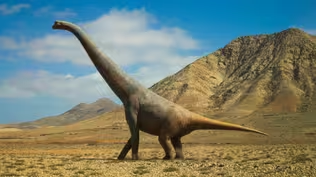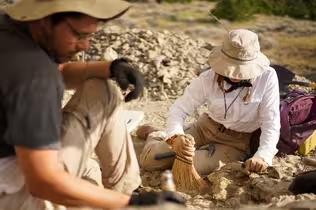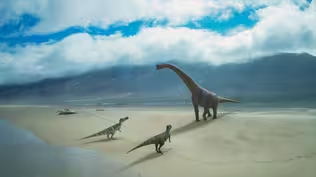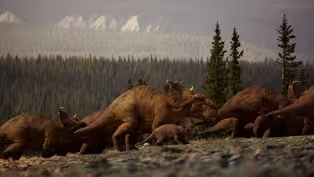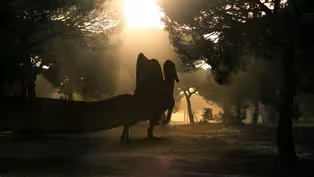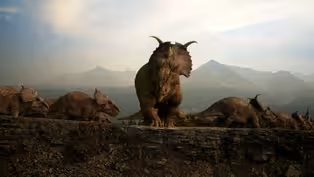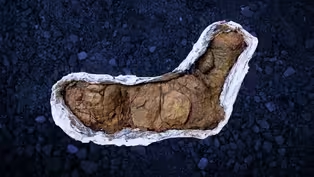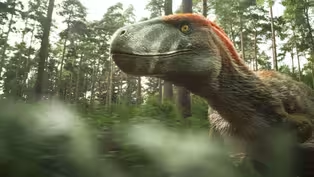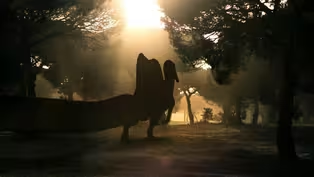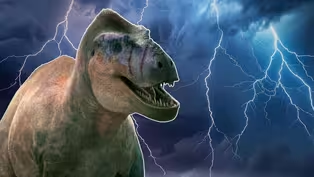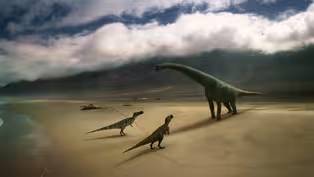
Did a Meteor Kill All the Dinosaurs?
Special | 5m 42sVideo has Closed Captions
Did the asteroid kill the T. rex and Triceratops?
T. rex and Triceratops were both alive at the moment an asteroid collided with Earth 66 million years ago, but did it kill them? In the rocks across Montana, a mysterious layer is found separating dinosaur skeletons from the creatures and worlds that arose after the impact. Now, a new theory may shed light on how these species met their end…
Problems playing video? | Closed Captioning Feedback
Problems playing video? | Closed Captioning Feedback
Narrator: Bertie Carvel With Thanks: North. Carolina Museum of Natural Sciences, Montana Dig Team Digital Producer & Director: Mark Atwill Digital Producer: Tom Heyden Post Production: Envy Post Production Visual...

Did a Meteor Kill All the Dinosaurs?
Special | 5m 42sVideo has Closed Captions
T. rex and Triceratops were both alive at the moment an asteroid collided with Earth 66 million years ago, but did it kill them? In the rocks across Montana, a mysterious layer is found separating dinosaur skeletons from the creatures and worlds that arose after the impact. Now, a new theory may shed light on how these species met their end…
Problems playing video? | Closed Captioning Feedback
How to Watch Walking with Dinosaurs
Walking with Dinosaurs is available to stream on pbs.org and the free PBS App, available on iPhone, Apple TV, Android TV, Android smartphones, Amazon Fire TV, Amazon Fire Tablet, Roku, Samsung Smart TV, and Vizio.
Providing Support for PBS.org
Learn Moreabout PBS online sponsorshipMore from This Collection
Check out our 12 digital exclusives from our series Walking with Dinosaurs with BBC.
When Dinosaurs Ruled the Arctic Circle
Video has Closed Captions
Very few dinosaurs made it as far North as the Arctic Circle...except for two. (5m 52s)
We Were Wrong About Spinosaurus
Video has Closed Captions
Millions of years ago, dinosaurs ruled the Earth. But underwater it was a totally different world. (6m 36s)
Were Dinosaur Brains Designed For Combat?
Video has Closed Captions
Did Pachyrhinosaurus bones always gather in such great numbers? (5m 42s)
How We Solve Jurassic Mysteries from One Bizarre Fossil
Video has Closed Captions
Would you lick a 65-million-year old dinosaur poop? (5m 19s)
How Walking with Dinosaurs Created the Most Accurate Dinos Ever
Video has Closed Captions
Join the team behind the scenes! (6m 32s)
How to Find a Dinosaur that Hollywood Dreamed Up
Video has Closed Captions
What would make a Utahraptor so much larger than other raptor species? (5m 50s)
How the Walking with Dinosaurs Team Brought a Dinosaur Back to Life
Video has Closed Captions
The Walking With Dinosaurs team reveal how they created the Spinosaurus. (5m 50s)
How Extreme Weather Is Revealing — And Destroying — Dinosaur Fossils
Video has Closed Captions
Imagine finding a rare fossil that you’ve been desperate to find - only for it to be put at risk. (5m 59s)
How an Evolutionary Arms Race Created Bizarre Dino Designs
Video has Closed Captions
It’s grudge match time. Except that this one took place over millions of years. (5m 32s)
The Dinosaurs that Could Cross the Atlantic
Video has Closed Captions
How did dinosaur fossils get there? (5m 42s)
Did Dinosaurs Abandon Their Young to Help Them Survive?
Video has Closed Captions
In late Cretaceous Alberta, many apex predators roamed free, so how did the prey survive? (5m 45s)
Providing Support for PBS.org
Learn Moreabout PBS online sponsorship[playful tune] [heavy footsteps] -[Narrator] Few creatures spark the imagination like T Rex.
And Triceratops, [deep bellows] perhaps the most iconic dinosaurs ever to have lived.
[hissing snarl] [deep bellow] They were also amongst the last to walk the Earth.
Today the remains of these giants litter the ground in Eastern Montana, a playground for paleontologists like Eric Lund who wants to learn more about how these icons met their end.
-[Eric Lund] They’re the last vestiges of the dinosaur rule.
They’re making a good go of it and they just got cut short.
-[Narrator] It came from outer space, an asteroid the size of Mount Everest smashing into the Atlantic Ocean off Mexico.
An event often thought of as wiping out the dinosaurs in an instant.
[explosion] [flying dinosaur screeching] But the truth isn’t nearly so simple.
-I’m sure some of them got obliterated, the ones very near the impact but here in Montana we’re far away from where that impact hit so they could have lasted hundreds of years after that impact.
-[Narrator] So what really killed off these giants?
-[Eric] As we walk from the bottom of this formation to the top, we’re going up through time.
There becomes a point where we sort of stop finding fragments, lose the dinosaurs.
-[Narrator] This is the exact spot in the fossil record where Triceratops and T Rex die out.
Eric’s drafted in paleontologist Michael Pittman to help him investigate this 66 million-year-old crime scene.
Michael has built a high-powered laser that highlights different element in rock.
-[Michael Pittman] The laser’s essentially giving us chemical information from the rocks that otherwise we wouldn’t be able to find with existing technologies.
-[Michael] Goggles on.
-[Eric] Yeah goggles on.
[flashlight clicks] -[Narrator] The laser scans across the surface.
While the camera photographs the glowing elements.
-[Michael] It’s actually lighting up a scorpion.
-[Narrator] And in just a few seconds, the image is ready.
-[Michael] So this is the image that we have and you’ll see... notice how there’s this layer.
-[Eric] Wow.
It’s cool to see.
-[Narrator] This faint line is rock rich in iridium.
-[Eric] And iridium doesn’t naturally occur often on Earth.
[explosion] -[Narrator] It was in the days and weeks after the asteroid hit that the deadliest damage occurred.
Several trillion tons of rock were ejected into space.
Rock that rained down on the land below.
Leaving behind a band of iridium that’s now been found in over 100 different locations all around the world.
[somber music] Proof that the asteroids impact affected the entire planet.
But Eric thinks even that wasn’t the full story.
-[Eric] The huge cloud of debris and ash, would have blocked out the sun for maybe many months, maybe years.
Would have been like nuclear winter.
[flames crackling] -[Narrator] The loss of the sun was the real killer.
A planet plunged into darkness.
-[Eric] You block out the sun so you start killing off the plants, you got no plants so you get no plant eaters coz they got nothing to eat and then the meat eaters can’t survive.
Would have been relatively slow process, it wasn’t an instantaneous event.
-[Narrator] Eventually decades after the asteroid struck, over 75% of life on earth was lost forever.
Including those giants of the Cretaceous, T Rex and Triceratops.
-[Eric] It’s possible without that asteroid impact things could have been completely different and dinosaurs could have lived for another 180 million years.
[insects chirping]

- Science and Nature

Explore scientific discoveries on television's most acclaimed science documentary series.

- Science and Nature

Capturing the splendor of the natural world, from the African plains to the Antarctic ice.












Support for PBS provided by:
Narrator: Bertie Carvel With Thanks: North. Carolina Museum of Natural Sciences, Montana Dig Team Digital Producer & Director: Mark Atwill Digital Producer: Tom Heyden Post Production: Envy Post Production Visual...

